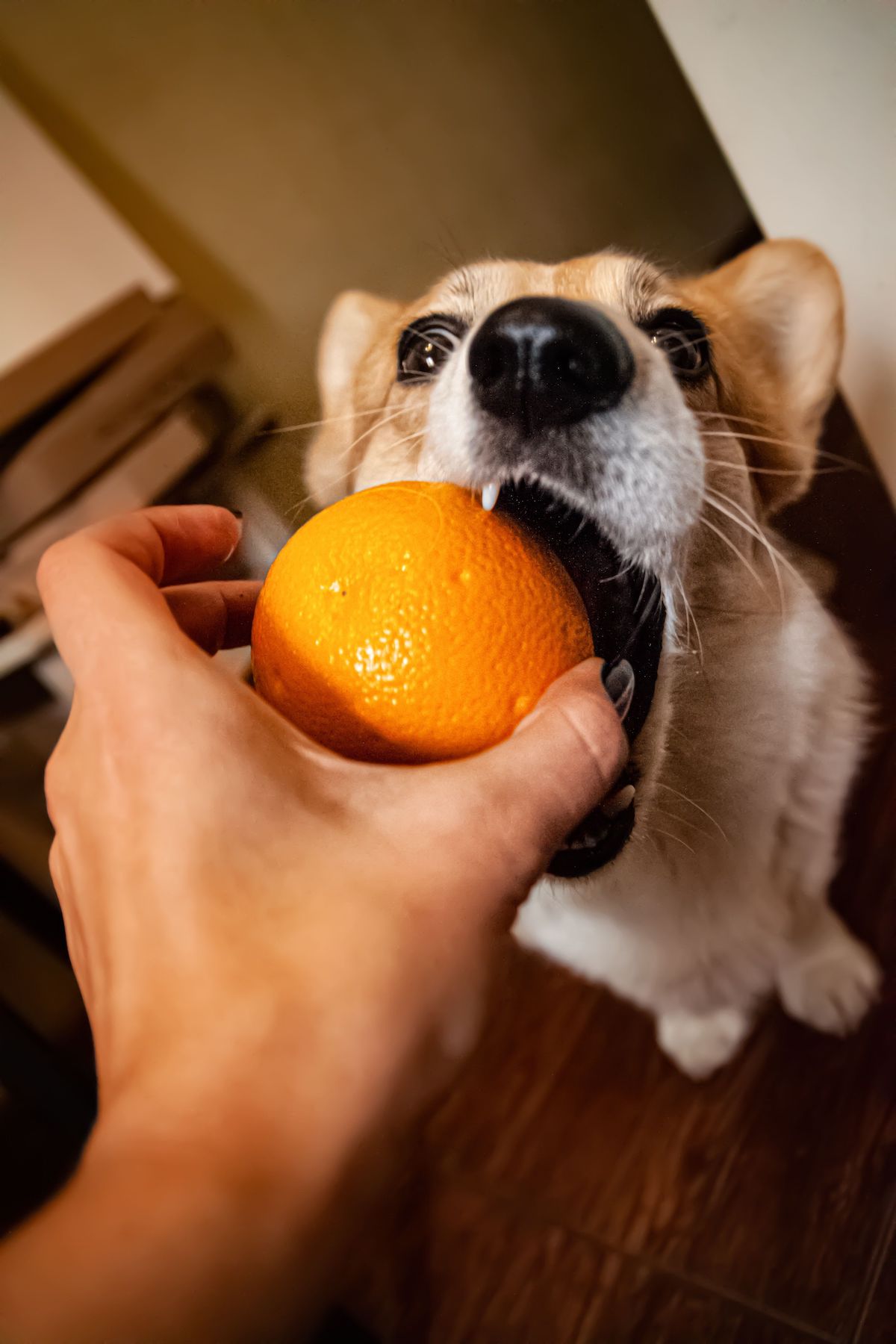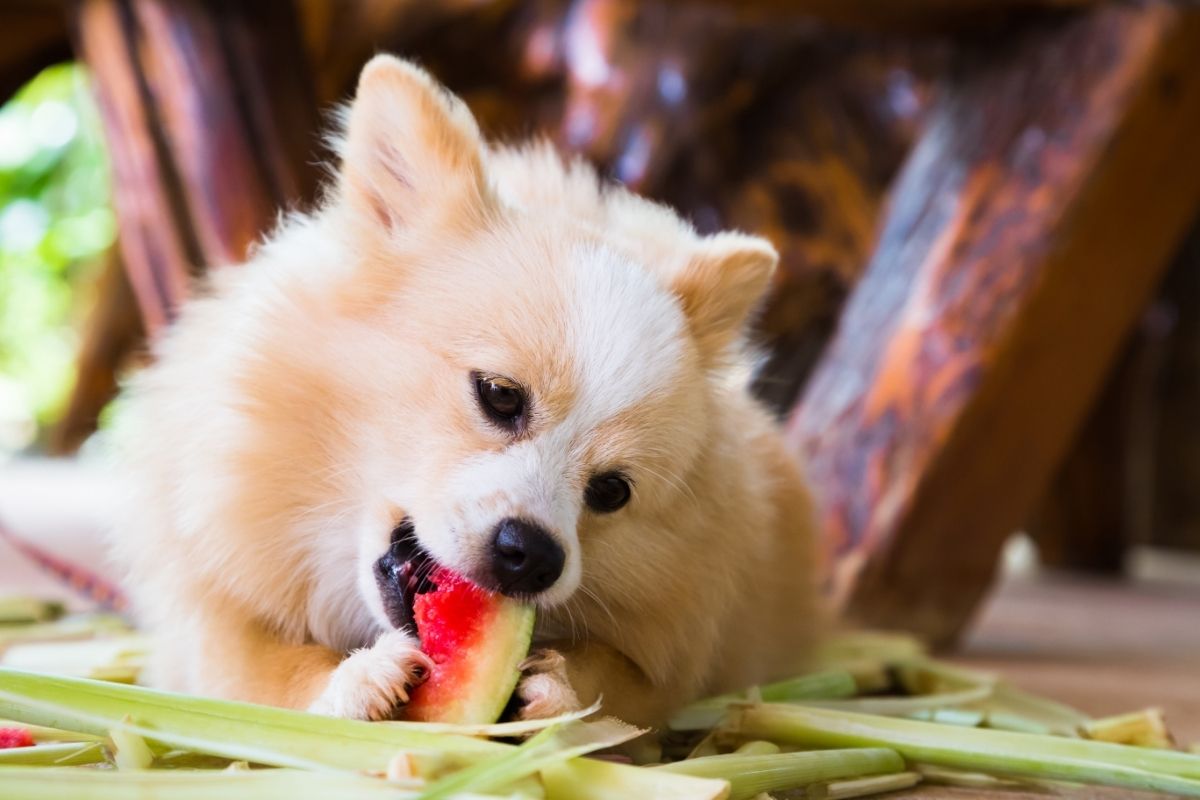Can Dogs Eat Fruit?
Imagine this; you’re sitting outside enjoying your morning tea when your pup gives you the “pretty please” look. So you think to yourself, “can dogs eat oranges?”.
It’s not uncommon to want to spoil your dog by sharing a few human treats here and there. But it’s important to consider if it’s something safe for them to eat. While many human foods are perfectly safe for dogs, some can be very unhealthy and dangerous.
It’s critical to learn which fruits and vegetables dogs can eat to save yourself and your pup from a vet visit.
Can Dogs Eat Oranges?
The good news is, yes, dogs can eat oranges. While some dogs may not enjoy the citric taste of the fruit, the fleshy part of oranges is safe for consumption. In addition, oranges are full of vitamin C and contain lots of potassium and fiber.
A high-quality doggy kibble fed daily is nutritionally complete. As such, oranges should only be given as a treat and not be a staple in their diet.
Dogs of all breeds, ages, and sizes can eat oranges. However, caution should be taken with dogs that have certain health conditions. For example, feeding oranges to diabetic dogs should be avoided. This is because the consumption of high sugar treats can impact blood sugar levels. This can then lead to a diabetic crisis.
Oranges should also be avoided for overweight dogs. While natural sugars are not inherently bad, large quantities of oranges can lead to excess calories.
Dogs with a history of sensitive gastrointestinal systems should not be offered oranges. The high sugar and acidic nature of oranges can cause stomach upsets.
All treats given to a dog should not be more than 10% of the dog’s daily caloric intake. If treats are being offered in excess, meal portions should be adjusted accordingly.

Are Oranges Good for Dogs?
Oranges are a healthy treat for dogs when given in appropriate amounts. They are full of vitamin C, which can benefit a dog’s immune system. Moreover, they are low in sodium.
However, oranges should only be given in small amounts, such as one or two segments a day.
What Fruits Can Dogs Eat Safely?
In addition to oranges, there are abundant amounts of fruits that dogs can have as treats.
Apples
Apples are a very healthy treat for dogs. They are full of vitamin A and C, as well as fiber. They are also low in protein and fat, which is perfect for dogs on a diet. It is essential to remove the core and any seeds before feeding apples to a dog. Apples can also be frozen and used as an icy treat for warmer weather.
Bananas
Bananas are another tasty treat that can be given in moderation. They are high in potassium, biotin, vitamins, and fiber. They are also low in cholesterol and sodium. However, bananas are high in sugar and should only be given as a treat.
Blueberries
Just as blueberries are a superfood for humans, this antioxidant-rich fruit is an excellent treat for dogs. They help to limit free radical damage in humans and canines alike. Blueberries are packed with fiber and phytochemicals as well.
Cantaloupe
Cantaloupe is another treat that is safe for dogs in moderation. It is packed with nutrients and is an excellent source of fiber. However, similar to oranges, they are high in sugar and should be avoided in diabetic or overweight dogs.
Cranberries
Cranberries are safe for dogs to eat in small quantities. This applied to both fresh and dried cranberries. However, whether or not your dog will like the tart flavor is another question.
Cucumbers
Cucumbers are another tasty treat perfect for the summertime. They are also great treats for overweight dogs as they hold little to no carbohydrates or fats. Cucumbers are full of vitamins K, C, and B1. They are also high in potassium, copper, magnesium, and biotin. This makes them a healthy and refreshing treat for dogs.
Mango
Mangoes are also safe for dogs as long as the pit is removed. The pit poses a choking hazard and can cause foreign gastrointestinal bodies. Mango flesh is full of vitamins A, B6, C, and E. They also have potassium, beta-carotene, and alpha-carotene. Mangoes should only be given as an occasional treat as they are high in sugar.
Peaches
Peaches are safe for dogs to eat. As with mangoes, it is vital to remove the pit before giving peaches to your dogs. Peaches are a great source of fiber and vitamin A. Avoid canned peaches as they contain high amounts of sugar syrups.
Pears
Pears are an excellent treat for dogs as they are high in vitamin C and K, copper, and fiber. Always remove the core and any seeds. As with peaches, skip canned pears because they contain high amounts of sugar.
Pineapple
Pineapples are another tasty, safe treat for dogs. Be sure to remove the prickly peel and crown first. The tropical fruit is full of vitamins, minerals, and fiber. Pineapples also contain bromelain, which is an enzyme that helps dogs absorb proteins.
Raspberries
Raspberries are another treat safe for dogs in moderation. They contain antioxidants that help to fight cell damage. They are also great treats for older dogs as they have anti-inflammatory properties. In addition, raspberries are high in fiber, manganese, and vitamin C. However, raspberries should only be given in small amounts as they do contain low levels of xylitol.
Strawberries
Strawberries are full of fiber and vitamin C. However, they are another treat that should only be given in moderation. This is due to their high sugar content. Strawberries also contain an enzyme that can help to keep a dog’s teeth white and shiny.
Watermelon
Watermelons are a fantastic treat for dogs. It is full of vitamins A, B6, and C. It is a great way to keep dogs hydrated on hot summer days. However, remember to remove the rind and seeds first, as they can cause gastrointestinal obstructions and upset stomachs.

Which Fruits are Bad for Dogs?
Avocado
Avocados are toxic for dogs. The pit, skin, and leaves of an avocado contain persin, which is a toxin that often causes vomiting and diarrhea in dogs. Therefore, avocados should always be avoided.
Cherries
Cherries can be harmful to dogs as cherry plants contain cyanide. Cyanide disrupts a cell’s ability to transport oxygen which means that the dog’s blood cells can’t get enough oxygen. So if your dog does eat cherries, keep an eye out for dilated pupils, difficulty breathing, and abnormal colored gums.
Grapes
Grapes should never be given to dogs. Grapes and raisins can cause acute kidney failure in any breed, sex, or age. If you notice your dog has eaten some grapes, make an appointment with the vet ASAP.

Tomatoes
Tomatoes are another no-no fruit for dogs. While the ripened fruit of a tomato plant is generally considered safe, the green parts are toxic. They contain a substance known as solanine. This can cause gastrointestinal distress, lethargy, weakness, and confusion.
While a dog needs to eat large amounts of a tomato plant to make them sick, it is better to avoid tomatoes to be safe.
The Differences Between the Canine and Human Digestive System
Mouth
Human: The jaw can move in a multitude of directions, and teeth are designed for grinding rather than tearing.
Dog: The jaw can only move up and down. Their teeth are designed to crush dense objects and tear flesh.
Saliva
Human: Contains various types of enzymes that break down food and lubricate for digestion.
Dog: Used to lubricate food but lack the enzymes to break food down. Dog saliva contains enzymes that kill off bacteria.
Stomach
Human: Digestion of food takes approximately one hour to move through the stomach.
Dog: Where a majority of food breakdown and digestion occurs. Their stomach is more acidic to facilitate the breakdown of meat and bone. Food transit time is typically 4 hours through the stomach.
Intestines
Human: Where absorption of nutrients takes place. The human intestinal tract is a lot longer than a dog’s. Thus there is more time to process and absorb nutrients from complex foods such as grains.
Dog: A shorter intestinal tract than humans giving them less time to absorb nutrients from their food.
The Dangers of Feeding Your Dog Oranges?
While oranges are safe for dogs to eat, there are a few things to keep in mind. First, as mentioned, oranges have moderate sugar content. This can cause GI upset if given in excessive amounts.
Oranges should be avoided in diabetic and overweight dogs. A spike in sugar levels can cause a diabetic crisis.
Always be sure to remove any peels and seeds. Orange peels are not toxic but can become obstructed in the GI tract. This can lead to surgery for removal. Orange peels are also tougher for dogs to digest and can, once again, cause GI upset.
FAQs on Oranges and Dogs
Can my dog eat orange peels?
Dogs should not eat orange peels. While some dogs may love all parts of an orange, only the flesh is safe for consumption. Also, as mentioned, the peels can cause GI upset and foreign body obstructions.
How much of an orange can dogs eat?
Oranges should only be given as a treat to complement their diet. They should not be given in amounts that will cause an imbalance of their nutritionally complete meals. Treats can make up to 10% of a dog’s total calories for the day. For most dogs, this means one to three orange sections.
How can I introduce oranges to my dog?
As with any treat, take things slow. Try feeding a single section and gauge their reaction. Oranges put off most dogs due to their citric nature.
Which type of oranges can dogs eat?
Dogs can eat any type of oranges. However, navel oranges are the best to try first due to their sweet nature. Moreover, they lack seeds and will be easier to segment.
Can dogs drink orange juice and other citrus juices?
Dogs can not drink orange juice or other citric juices. Even though orange juice is natural and comes from the fruit, it is a concentrated source. This means there is more sugar and citric acid than in a single section of orange. This can lead to GI upsets.
Can dogs eat other citrus fruits?
Dogs can eat other citric fruits such as tangerines. However, like oranges, they are high in sugars and calories. Likewise, lemons should be avoided, given their acidic nature.
Our Take Home Message
Fruits and vegetables can be a great addition to your dog’s diet in moderation. As with any treat, start slow and let your dog decide if they like it or not. Oranges can be a tasty, healthy treat for dogs that like them. Always remember to remove the peel and any seeds.
